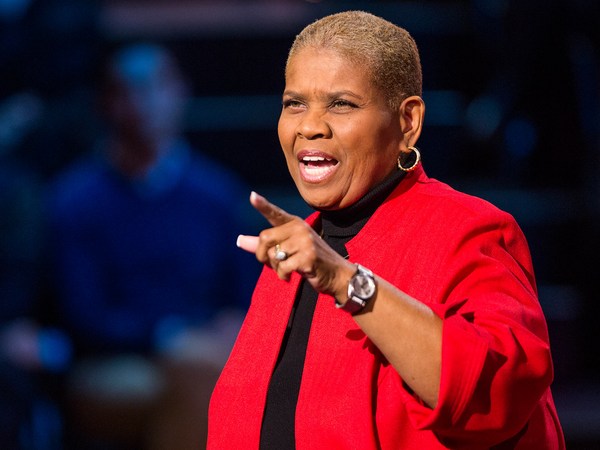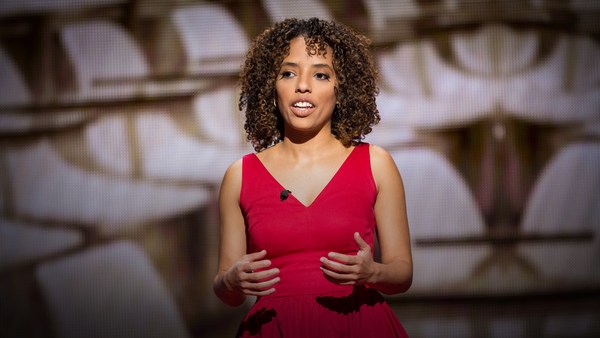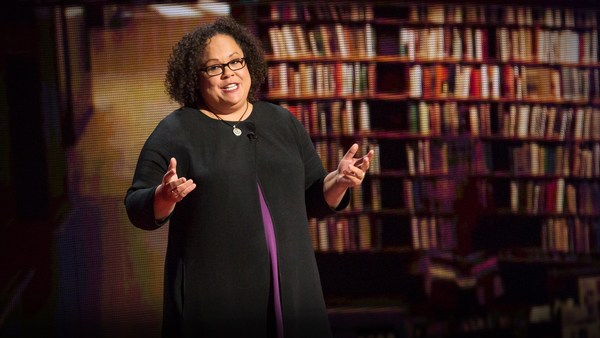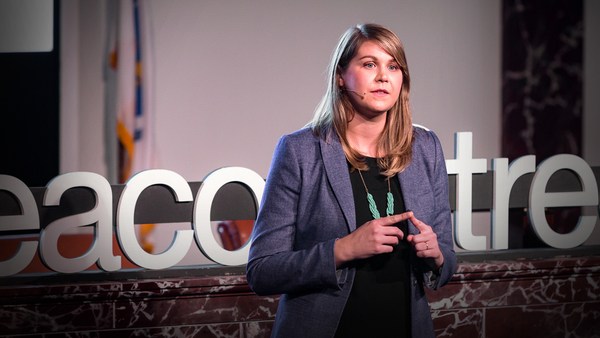So, a few years ago, I was beginning a new unit on race with my fourth-graders. And whenever we start a new unit, I like to begin by having all the students list everything they know about it, and then we also list questions we have. And I had the type of moment that every teacher has nightmares about. One of my students had just asked the question, "Why are some people racist?" And another student, let's call her Abby, had just raised her hand and volunteered: "Maybe some people don't like black people because their skin is the color of poop." Yeah, I know.
So, as if on cue, my entire class exploded. Half of them immediately started laughing, and the other half started yelling at Abby and shouting things like, "Oh, my God, you can't say that, that's racist!" So just take a second to freeze this scene in your mind. There's a class of nine- and ten-year-olds, and half of them are in hysterics because they think Abby has said something wildly funny, and the other half are yelling at her for saying something offensive. And then you have Abby, sitting there completely bewildered because, in her mind, she doesn't understand the weight of what she said and why everybody is reacting this way. And then you have me, the teacher, standing there in the corner, like, about to have a panic attack.
So as a classroom teacher, I have to make split-second decisions all the time. And I knew I needed to react, but how? Consider your fight-or-flight instincts. I could fight by raising my voice and reprimanding her for her words. Or flight -- just change the subject and quickly start reaching for another subject, like anything to get my students' minds off the word "poop." However, as we know, the right thing to do is often not the easy thing to do. And as much as I wanted this moment to be over, and that I knew both of these options would help me escape the situation, I knew that this was far too important of a teachable moment to miss.
So after standing there for what felt like an eternity, I unfroze and I turned to face my class, and I said, "Actually, Abby makes a point." And my students kind of looked at each other, all confused. And I continued, "One reason why racism exists is because people with light skin have looked at people with dark skin and said that their skin was ugly. And even use this reason as an excuse to dehumanize them. And the reason why we're learning about race and racism in the first place is to educate ourselves to know better. And to understand why comments like this are hurtful, and to make sure that people with dark skin are always treated with respect and kindness."
Now, this was a truly terrifying teachable moment. But as we moved forward in the conversation, I noticed that both Abby and the rest of the kids were still willing to engage. And as I watched the conversation really marinate with my students, I began to wonder how many of my students have assumptions just like Abby. And what happens when those assumptions go unnoticed and unaddressed, as they so often do?
But first, I think it's important to take a step back and even consider what makes a topic taboo. I don't remember receiving an official list of things you're not supposed to talk about. But I do remember hearing, over and over, growing up: there are two things you do not talk about at family get-togethers. And those two things are religion and politics. And I always thought this was very curious because religion and politics often are such huge influencing factors over so many of our identities and beliefs. But what makes a topic taboo is that feeling of discomfort that arises when these things come up in conversation. But some people are extremely fluent in the language of equity, while other people fear being PC-shamed or that their ignorance will show as soon as they open their mouths. But I believe that the first step towards holding conversations about things like equity is to begin by building a common language. And that actually starts with destigmatizing topics that are typically deemed taboo.
Now, conversations around race, for example, have their own specific language and students need to be fluent in this language in order to have these conversations. Now, schools are often the only place where students can feel free and comfortable to ask questions and make mistakes. But, unfortunately, not all students feel that sense of security.
Now, I knew that day in front of my fourth-graders that how I chose to respond could actually have life-long implications not only for Abby, but for the rest of the students in my class. If I had brushed her words aside, the rest of the class could actually infer that this type of comment is acceptable. But if I had yelled at Abby and embarrassed her in front of all of her friends, that feeling of shame associated with one of her first conversations on race could actually prevent her from ever engaging on that topic again.
Now, teaching kids about equity in schools is not teaching them what to think. It is about giving them the tools and strategies and language and opportunities to practice how to think. For example, think about how we teach kids how to read. We don't start by giving them books. We start by breaking down words into letters and sounds and we encourage them to practice their fluency by reading every single day, with a partner or with their friends. And we give them lots of comprehension questions to make sure that they're understanding what they're reading. And I believe that teaching kids about equity should be approached in the exact same way.
I like to start by giving my students a survey every year, about different issues around equity and inclusion. And this is a sample survey from one of my kids, and as you can see, there's some humor in here. For under the question, "What is race?" she has written, "When two or more cars, people and animals run to see who is fastest and who wins." However, if you look at her question, "What is racism?" it says, "When somebody says or calls someone dark-skinned a mean name." So, she's young, but she's showing that she's beginning to understand. And when we act like our students aren't capable of having these conversations, we actually do them such a disservice.
Now, I also know that these types of conversations can seem really, really intimidating with our students, especially with young learners. But I have taught first through fifth grades, and I can tell you, for example, that I'm not going to walk into a first-grade classroom and start talking about things like mass incarceration. But even a six-year-old first-grader can understand the difference between what is fair -- people getting what they need. We identified a lot of these things in class together. And the difference between fair and equal -- when everybody gets the same thing, especially goody bags at birthday parties. Now, first-graders can also understand the difference between a punishment and a consequence. And all of these things are foundational concepts that anyone needs to understand before having a conversation about mass incarceration in the United States.
Some people might think that kindergarteners or first-graders are too young to have conversations around racism, but also tell you that young kids understand that there are many different components that make up our identities and how people are similar and different, and what it means to have power when other people don't. When we have these conversations with students at a young age, it actually takes away some of that taboo feeling when those topics come up at a later age.
I also know that teaching about these things in schools can feel like navigating a minefield. For example, what happens if parents or families aren't on board with having these conversations in schools? But to these people, I can say: these are some examples of things that students have said to me and brought to my attention. For example, I had a student come in and whisper to me, "I've heard all these people use the term LGBTQ, but I don't know what it means and I'm too embarrassed to admit it." I had a student come in over a weekend and come up to me and say, "You know, I just watched this movie about Australia, and it made me wonder if they have racism there, too." And I always want my students to be comfortable having these conversations because when they're comfortable talking about it and asking questions, they also build comfort in bringing in their own lives and experiences in how they relate to these big topics.
Also, some teachers might be kind of nervous if a student brings up a topic or asks a question and they don't know the answer to it. But if a student ever brings something to my attention and I don't know the answer, I will always admit it and own it because I'm not going to pretend to be an expert in something that I don't have experience in or I'm not an authority on. That same year, I had a student come in and ask a question about the LGBTQ community. And I just didn't know enough to give them an appropriate answer. So instead, I encouraged that student to reach out and ask that question to a representative of a nonprofit who had come to speak to our class about that very same issue. When we admit to our students that we don't have all the answers, not only does it humanize us to them, it also shows them that adults have a long way to go, too, when it comes to learning about issues of equity.
Now, a little while back, I wrote a lesson about consent. And, to some people, this was very exciting because I took this topic that seemed very taboo and scary and I broke it down into a way that was accessible for young learners. However, to other people, the idea of consent is so strongly tied to sex, and sex is often considered a taboo subject, that it made them very uncomfortable. But my students are third-graders, so we're not talking about sex in class. Rather, I wanted them to understand that everybody has different physical boundaries that make them feel comfortable. And the social and emotional intelligence it takes to read somebody's words and tone and body language are skills that often need to be explicitly taught, the same way we teach things like reading and math. And this lesson is not reserved for students of one single demographic. Things like questioning and making observations and critical thinking are things that any student of any race or ethnicity or background or language or income or zip code should be learning in schools.
Also, deliberate avoidance of these conversations speaks volumes to our students because kids notice when their teachers, when their textbooks leave out the voices and experiences of people like women or people of color. Silence speaks volumes.
I recently asked my class of third-graders what they would say to adults who think they're too young to learn about issues of equity. And while this is a small sample of my 25 students, all of them agreed that not only are they capable of having these conversations, but they view it, the right to learn it, as a right and not as a privilege. And, in their words: "We're big enough to know about these things because these problems are happening where we live. And we have the right to talk about them because it will be our life in the future."
Thank you.
(Applause)





